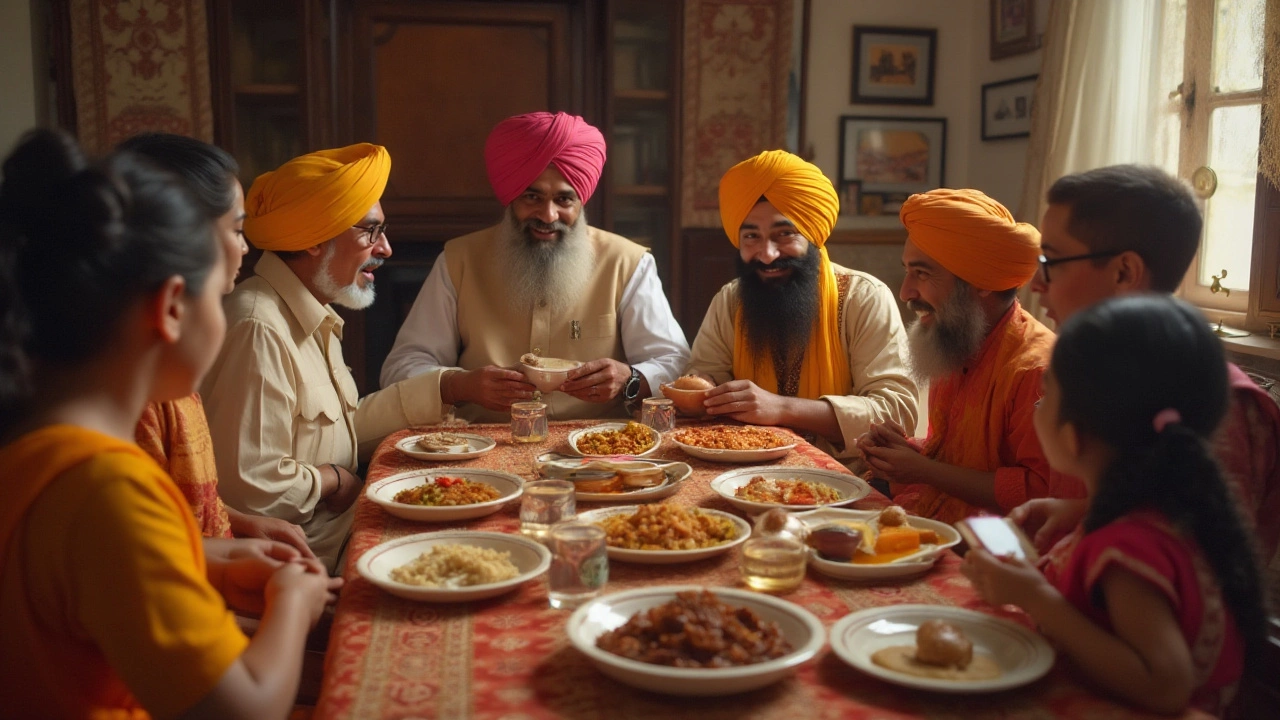How to Respectfully Greet a Sikh: A Non-Sikh's Guide

India is a land of diverse cultures and religions, each with its own unique traditions and customs. Among these is Sikhism, a notable faith originating from the Punjab region, known for its vibrant community and distinct identity. For someone not born into the religion, the nuances of how to greet a Sikh might not be immediately apparent. Yet, understanding these courtesies can go a long way in showing respect and building connections.
Sikhs are known for their hospitality and openness, yet their traditions carry a depth that deserves recognition. When greeting a Sikh individual, especially on occasions such as birthdays, it's important to consider the cultural context behind the greeting. It is a gesture that transcends mere words, reflecting mutual respect and awareness of each other's heritage.
This guide offers insights into these greetings and seeks to bridge the gap between Sikhs and non-Sikhs, ensuring that even if our backgrounds differ, our gestures of goodwill carry the same warmth.
Understanding Sikhism
At the heart of Indian cultural and spiritual tapestry lies Sikhism, a monotheistic religion founded in the late 15th century in the Punjab region of South Asia. With over 25 million adherents worldwide, it's one of the world's major religions. Its founder, Guru Nanak, paved the way for what would evolve into a rich and distinct religious identity built on principles of equality, honesty, and community service. In a society historically divided by caste and class, Sikhism's early teachings emphasized that all people are equal in the eyes of God, regardless of their social status, wealth, or caste.
The term 'Sikh' itself means 'learner' or 'disciple,' reflecting the commitment of Sikhs to follow the teachings of their ten Gurus, as compiled in their holy scripture, the Guru Granth Sahib. This book is not just a religious text but also a living Guru that guides the followers' life decisions, philosophy, and community practices. The principles laid out by the Gurus cultivate a strong sense of community service and peace, embodied in the tradition of 'Langar' – community kitchens where free meals are served to all visitors without exception. This tradition of generosity and open-heartedness extends to how Sikhs engage with the broader world, making them known for their hospitality and welcoming nature.
The essence of Sikh greeting practices intertwines deeply with their spiritual and cultural identity. Respect and mutual acknowledgment are fundamental in Sikh greetings, most commonly expressed through the phrase "Sat Sri Akal," which means "God is the timeless truth." This greeting is a reflection of a spiritual state that respects the divine in every individual. It's more than a simple exchange of words; it's a heartfelt mark of recognition. With Sikhs' distinctive appearance—many males wear turbans and maintain unshorn hair as part of their faith practice—greetings also become a moment of cultural acknowledgment.
A BBC article once mentioned, "Sikhism preaches a message of devotion and remembrance of God at all times, truthful living, equality of mankind, and social justice." This drives home the point that every gesture, including greetings, serves to uphold their cherished values.
In every interaction, understanding the depth and history of Sikhism fosters a connection that transcends cultural boundaries. By acknowledging their traditions, non-Sikhs engage in an authentic exchange that respects the shared humanity we all hold while recognizing the beauty in our differences. Through this understanding, we’re better positioned to celebrate moments like birthdays with the sincerity Sikhs bring to their lives.

Common Sikh Greetings
Greeting a Sikh individual involves more than just exchanging pleasantries; it’s a reflection of respect and understanding. The most widely recognized greeting within the Sikh community is 'Sat Sri Akal'. This phrase translates to 'God is the eternal truth.' It beautifully encapsulates a core element of Sikh beliefs and is used universally among Sikhs across the world. When greeting a Sikh, using this phrase can show an informed and respectful gesture toward their cultural heritage.
Interestingly, the greeting 'Sat Sri Akal' is not just a salutation. It's a proclamation, an assertion of the truth as seen through the lens of Sikh philosophy. Another popular greeting you might encounter is 'Waheguru Ji Ka Khalsa, Waheguru Ji Ki Fateh'. This greeting translates to 'The Khalsa belongs to God, Victory belongs to God' and is often used on religious occasions or during formal gatherings to convey a deeper spiritual connection. It reflects the community's devotion and acknowledgment of God in all things. With this understanding, you realize that greeting practices are woven intricately with their beliefs, making it more than just words.
For non-Sikhs, engaging in a greeting can sometimes feel daunting. While 'Sat Sri Akal' remains the most accessible, a warm smile paired with it enhances the sincerity of the gesture. Sikhs deeply value such expressions of mutual goodwill. It’s the acknowledgment of their identity that facilitates a welcoming rapport. A common misconception is that one should only greet in Punjabi, but the truth is it's the intent behind your greeting that matters more. Sikhs are generally appreciative of the effort you make to acknowledge their culture in any capacity.
In occasions such as birthday celebrations, adding a simple 'Happy Birthday' after 'Sat Sri Akal' can make the interaction feel personal and tailored. Many Sikhs might invite you to partake in traditional sweets or treats as part of their hospitality—an interaction that elevates the greeting into a shared experience. As a tip, embracing these moments and partaking in their hospitality warmly can strengthen bonds and contribute to meaningful cross-cultural proximities.
Renowned Sikh author and theologian, Harbans Singh, once said,
"A greeting is but the first step towards sharing the beautiful wisdom that Sikhism holds. When someone acknowledges our greeting, they haven't just spoken words; they've opened a door to understanding."These words reflect the importance of greetings as an avenue to connect and understand the depths of Sikh heritage.

Tips for Non-Sikhs
Engaging with people from different cultures can be both enlightening and rewarding. For non-Sikhs, understanding how to properly greet a Sikh individual is a meaningful step in showing respect and appreciation for their rich cultural heritage. One of the most recognized greetings in the Sikh culture is "Sat Sri Akal," a Punjabi phrase that translates to "God is the eternal truth." This expression not only serves as a greeting but also resonates deeply with the spiritual teachings of Sikhism.
To greet a Sikh sincerely, it is important to embrace the full essence of the words. Pronouncing "Sat Sri Akal" correctly with the intended reverence is essential. It reflects an understanding and respect for Sikh beliefs, rather than it being a perfunctory salutation. Sikhs are warm and welcoming, and responding to you with a genuine smile or nod is their way of acknowledging your intent. It's essential to remember that gestures matter as much as words, so accompany your greeting with a gentle nod or folded hands if appropriate.
Understanding the context of the interaction is also crucial. For instance, during significant occasions such as birthdays or cultural festivals, knowing how to greet in a way that honors their traditions can enhance your connection. Birthdays in Sikhism, much like in other cultures, are celebratory but are often observed with an emphasis on humility and gratitude. To extend birthday wishes, you may add "Janamdin di lubh lubh vadhai," which wishes the person abundance and blessings. Incorporating these expressions can strengthen bonds and foster goodwill.
Sikhs uphold values of equality, community service, and humility. When interacting with Sikh individuals, showing an understanding and respect for these values is beneficial. Acknowledging their tradition of community service, known as "seva," and expressing admiration for it in conversation can demonstrate genuine interest and respect. A respectful inquiry about their customs or religious practices can open the door to a deeper dialogue, where learning becomes a shared and enriching experience for both parties involved.
Sikh author Khushwant Singh once remarked, "You cannot understand the teachings of the Guru by merely reading their words; you must experience their warmth and humanity." This reflection encapsulates the heart of Sikh greetings and interactions, which are about transcending mere formality to embody genuine connection.
Being sensitive to cultural differences is vital for smooth interactions. Head coverings hold significant meaning in Sikhism; the turban or "dastaar" symbolizes honor and spirituality. When meeting a Sikh, especially in a personal space like their home, it's considerate to acknowledge their practices, such as keeping their heads covered. Similarly, when visiting a Gurdwara, a Sikh place of worship, it is polite to cover your head and remove shoes, showcasing your respect for their customs.
Lastly, in your quest to greets Sikhs appropriately, always be open-hearted and ready to learn. Their culture, filled with vibrant traditions and spiritual depth, offers profound insights into values of kindness, integrity, and community. Every interaction is an opportunity to learn and grow, building bridges of understanding that extend beyond cultural boundaries. Through respectful engagement and a willingness to embrace new cultural norms, non-Sikhs can enjoy a deeply rewarding experience interacting with the Sikh community.

Cultural Sensitivities
When it comes to interacting with individuals from different cultures, understanding and respecting cultural sensitivities is of paramount importance. Sikhism, being a profound and deeply spiritual culture, places significant emphasis on respectful and meaningful interactions. This is prominently seen in their greetings, which are not just about words but carry a heartfelt weight of mutual respect and understanding. For anyone who is not part of the Sikh community— whether a tourist, a new friend, or someone encountering a Sikh for the first time— knowing how to approach these greetings empathetically can be incredibly enriching.
It is important for non-Sikhs to appreciate the significance of symbols and practices in Sikh culture. A key element here is the presence of the turban, or 'Dastar,' which many Sikh men wear. The Dastar signifies honor, self-respect, courage, spirituality, and piety. Commenting casually on the turban or appearing dismissive of its meaning can inadvertently offend. Instead, a simple compliment can be an excellent way to express admiration. Moreover, the condition of the head being covered when inside a Gurdwara (Sikh temple) also underlines the sense of modesty and gratitude displayed in Sikhism.
"A respectful greeting is a doorway to human connection, where understanding and kindness flow." - Cultural Anthropologist, Davinder Sidhu.Additionally, language itself can be a bridge of connection or division. Many Sikhs speak Punjabi as their native language, and while English is widely spoken, any attempt to learn even a few basic Punjabi phrases can be seen as an effort to connect more earnestly, something that would surely be appreciated. Subtle aspects, like using "Sat Sri Akal" instead of a simple "Hello," can make a world of difference.
Beyond words, gestures themselves hold value. A warm smile is universal, but understanding the significance of the traditional, Indian 'Namaste' or 'Sat Sri Akal' accompanied by a slight bow with hands pressed together can be seen as a respectful gesture when meeting Sikhs. This act emphasizes humility and acknowledges the presence of another person’s spirit, an essence cherished across Indian traditions.
Being mindful of religious practices is equally critical. Dietary habits are another area where cultural sensitivities can rise. Many Sikhs follow vegetarian diets due to religious beliefs, especially when it comes to food prepared in a religious setting. Assuming dietary preferences without asking can lead to awkward situations. On special occasions like birthdays, being considerate enough to offer or arrange for vegetarian options is perceived as both thoughtful and appreciative of their beliefs.
Sikh greetings and interactions are steeped in cultural richness. These cultural sensitivities provide a glimpse into a worldview that prioritizes respect, humility, and acknowledgment of shared humanity. Implementing the knowledge of these customs and sensitivities nurtures the foundation for genuine connections, bridging gaps through empathy and understanding. It is this understanding that transforms simple gestures into profound, meaningful exchanges.